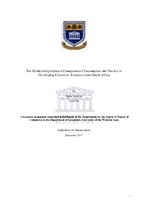| dc.description.abstract | For many years the word poverty was synonymous with deprivation and the inability to satisfy basic necessities. According to Alkire and Santos (2014:257), about 1.67 billion people in developing countries lived below the then poverty line of $1.25 per day, while a staggering 2.74 billion lived on less than a higher poverty line of $2 a day, using the US Purchasing Power Parity (PPP). In the midst of the hunger and constrained resources implied by these statistics, it is alarming that the poor allocate a significant share of their limited income to expensive visible consumption that does not effectively alleviate poverty or increase their well-being. This puzzling behaviour was first identified by Veblen (1899) as 'conspicuous consumption', and is described by Kilsheimer (1993:341) as 'the motivational process by which individuals strive to improve their social standing through the conspicuous consumption of consumer products that confer and symbolise status both for the individual and surrounding significant others'. Unlike the affluent, when poor households engage in conspicuous consumption they are forced to neglect basic needs such as education, nutrition and health care, as they are under severe monetary constraint (Linssen, Van Kempen & Kraaykamp, 2011:61). For this reason Moav and Neeman (2012:936) argue that conspicuous consumption by poor households in developing countries is to blame for persistent poverty as well as inequality. Against this backdrop, this study sought to determine the degree of correlation between conspicuous consumption and poverty. Specifically, to what extent does conspicuous consumption contribute to increasing poverty in South Africa? In addressing this research question, the study used officially published data from the National Income Dynamics Study (NIDS), starting from the first wave in year 2008 to the last during 2014/2015. The study found that South African adults, including the poor, have gradually increased their household expenditure share on visible consumption (personal care, cellphones, shoes and clothing). This increase in visible consumption among the poor coincided with a decline in food consumption, suggesting that food consumption was reduced to engage in conspicuous consumption. This consumption behaviour is most prevalent among the poor and the African population group. Hence a correlation between poverty and conspicuous consumption in South Africa is postulated. | |

